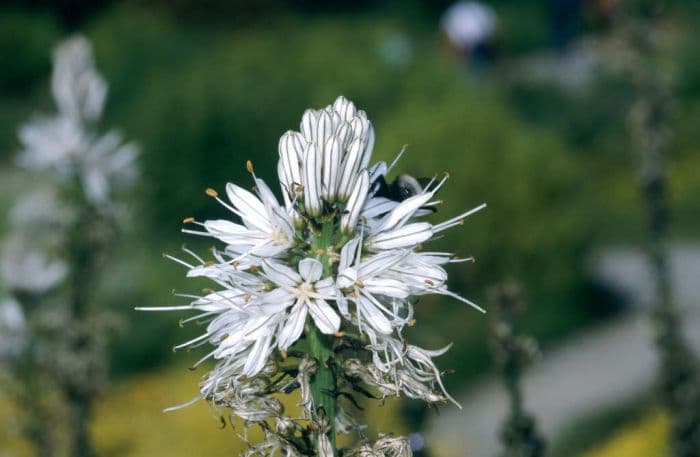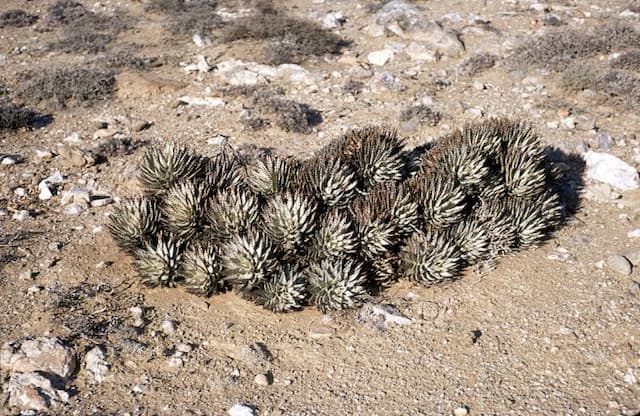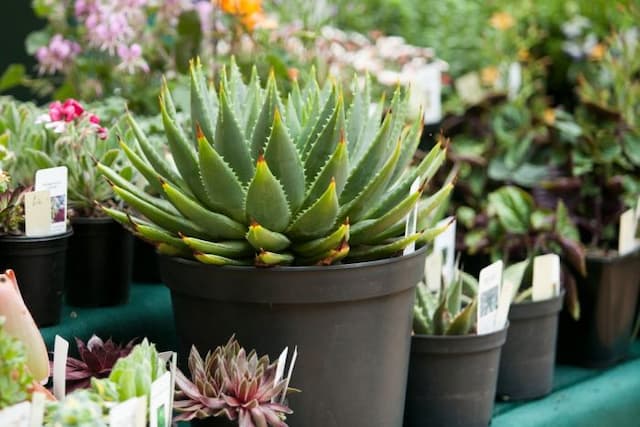White asphodel Asphodelus albus

ABOUT
The Asphodelus albus, commonly known as the white asphodel, is a strikingly elegant plant known for its tall spire of star-shaped white flowers, which are gathered in a dense cluster. Each flower bears six tepals, usually adorned with a central brown or reddish streak that contrasts beautifully with the petal's snowy whiteness. The stamens protrude from the flower's center, tipped with yellow anthers that add a subtle warmth to the floret. A distinguishing feature of the white asphodel is its long, linear leaves that form a base rosette around the plant's lower section. These leaves are fleshy with a grey-green coloration and may have a slight curve, embracing the stem and creating a visually appealing, grassy mound from which the floral spike emerges. The overall aspect of the white asphodel is one of statuesque grace, with its flower spike rising determinedly and culminating in an impressive display that can be quite captivating when seen en masse. These blossoms are a common sight in their native habitats, dotting the landscape with specks of white that contrast with the surrounding greenery.
About this plant
 Names
NamesSynonyms
White Asphodel, Asphodel, Branched Asphodel.
Common names
Asphodelus bakeri, Asphodelus ramosus subsp. albus.
 Toxicity
ToxicityTo humans
White asphodel (Asphodelus albus) has been mentioned in historical texts for its various uses, but modern scientific evidence about its toxicity to humans is limited. Historically, parts of the plant have been used for medicinal purposes, but it should be noted that improper use or consumption of white asphodel may potentially cause gastrointestinal discomfort, such as nausea or diarrhea. It's important to treat plants with caution and avoid ingesting any part of the white asphodel unless it is deemed safe by a qualified expert. Always consult a medical professional or a poison control center if you suspect poisoning.
To pets
White asphodel (Asphodelus albus) is not commonly listed as a toxic plant to pets, such as dogs and cats. However, the lack of detailed toxicity studies means that its ingestion by pets should still be avoided due to the potential risk of gastrointestinal upset, similar to that which could possibly occur in humans. If you suspect your pet has ingested part of the white asphodel plant and is showing signs of distress (such as vomiting, diarrhea, or changes in behavior), it is important to contact your veterinarian.
 Characteristics
CharacteristicsLife cycle
Perennials
Foliage type
Deciduous
Color of leaves
Green
Flower color
White
Height
2-3 feet (60-90 cm)
Spread
1-2 feet (30-60 cm)
Plant type
Herb
Hardiness zones
7
Native area
Mediterranean
Benefits
 General Benefits
General Benefits- Ornamental Value: The white asphodel is valued for its tall, striking flower spikes and is often used in gardens and landscaping for aesthetic appeal.
- Drought Resistance: White asphodel is adaptable to dry conditions, making it suitable for xeriscaping and low-water gardens.
- Soil Erosion Control: The root system of white asphodel helps to stabilize soil and prevent erosion on slopes and embankments.
- Habitat for Wildlife: The flowers of white asphodel can attract pollinators such as bees, contributing to the biodiversity of an area.
- Cultural and Historical Significance: White asphodel has a rich history in mythology and literature, often symbolizing peace and death.
 Medical Properties
Medical Properties-
- Anti-inflammatory: The plant has been traditionally used for its anti-inflammatory properties.
- Diuretic: Asphodelus albus may have diuretic effects and has been used to promote the production of urine.
- Emollient: The mucilaginous properties of the plant allow it to be used as an emollient to soothe and protect irritated or inflamed skin.
- Laxative: There is some historical use of this plant as a mild laxative, aiding in bowel movements.
- Wound healing: Due to its purported anti-inflammatory properties, the plant may have been used in traditional medicine to assist in the healing of wounds.
 Air-purifying Qualities
Air-purifying QualitiesThis plant is not specifically known for air purifying qualities.
 Other Uses
Other Uses- The roots of the Asphodel (Asphodelus albus) can be used for manufacturing glue. The sticky quality of the root sap makes it suitable for this purpose.
- Fibres from Asphodel can be used for making paper. The plant's fibrous stalks have been traditionally used in papermaking processes.
- The Asphodel can be employed as a garden ornamental. Its tall, striking flower stalks and white flowers make it a popular choice for gardeners seeking a Mediterranean feel.
- Stalks of Asphodel have been used historically for weaving baskets. The rigidity and length of the stalks lend themselves well to the craft.
- Asphodel seeds could serve as a food for certain bird species. While not extensively used, these seeds can augment the diet of wild birds in a natural setting.
- The sap from Asphodel, due to its viscosity, could potentially be used as a natural adhesive for small items or paper crafts, in line with traditional glue uses.
- Asphodel has been referenced in literature and mythology, often serving as a symbol or motif in poetry and stories. It has cultural significance, particularly in ancient Greek traditions where it was associated with the Elysian Fields.
- The plant has been used in the past to make dyes. Though not a common use today, historically the pigments derived from Asphodel were of practical value.
- Asphodel may be considered in permaculture designs. Its resilience and ability to grow in poor soils make it a candidate for soil stabilization and use in sustainable landscaping.
- Dried Asphodel flowers can be incorporated into potpourri mixes, adding fragrance and aesthetic appeal to the mixture.
Interesting Facts
 Feng Shui
Feng ShuiThe White Asphodel is not used in Feng Shui practice.
 Zodiac Sign Compitability
Zodiac Sign CompitabilityThe White Asphodel is not used in astrology practice.
 Plant Symbolism
Plant Symbolism- Afterlife: Asphodel, the common name of Asphodelus albus, is often associated with the afterlife, especially in Greek mythology. Asphodel Meadows was the place where the souls of the ordinary deceased resided.
- Eternal Rest: Asphodel is symbolic of eternal rest and peace, as it was believed to cover the Elysian Fields, which is a final resting place for souls.
- Mourning: Due to its connection with death and the afterlife, asphodel is commonly associated with mourning, representing a connection to those who have passed on.
- Forgotten or Lost Love: In Victorian flower symbolism, asphodel sometimes signifies forgotten or lost love, possibly due to its ghostly associations and its presence in graveyards.
 Water
WaterWhite asphodels should be watered moderately during their growing season. They prefer a well-drained soil, which means the soil should not remain soggy after watering. Generally, provide about 1 inch of water per week, but this can vary depending on soil type and climate. In particularly hot or dry periods, you may need to water twice a week. During the dormant season, reduce watering significantly to prevent root rot. It's crucial to avoid overwatering to mimic the plant's natural arid habitat.
 Light
LightWhite asphodel thrives in full sunlight to partial shade. The best spot for these plants is one where they can enjoy at least six hours of direct sunlight per day. They can tolerate some light shade, especially in hotter climates, but full sun is ideal for robust growth and flowering. Avoid deep shade as it can lead to weak growth and fewer flowers.
 Temperature
TemperatureWhite asphodel prefers a temperate climate and is hardy in a range of temperatures. The plant can survive minimum temperatures down to around 10 degrees Fahrenheit and maximum temperatures well above 100 degrees Fahrenheit. For optimal growth, maintain temperatures between 50 and 75 degrees Fahrenheit, which is ideal for this species.
 Pruning
PruningPruning white asphodel is typically limited to cutting back spent flower stalks after blooming, which encourages a tidy plant appearance and potential re-blooming. Dead or damaged foliage should also be removed to maintain health. The best time for pruning is immediately after flowering, typically in late summer or early fall.
 Cleaning
CleaningAs needed
 Soil
SoilWhite asphodel prefers well-draining soil with a neutral to slightly alkaline pH, typically around 6.0 to 8.0. A mixture of sand, perlite, and loam works well to ensure adequate drainage and nutrients.
 Repotting
RepottingWhite asphodel does not require frequent repotting. They can be repotted once every 2-3 years, or when the root system outgrows the current container.
 Humidity & Misting
Humidity & MistingWhite asphodel thrives in moderate humidity levels but is quite adaptable and can tolerate the drier conditions typical of Mediterranean environments.
 Suitable locations
Suitable locationsIndoor
Place white asphodel in bright indirect light.
Outdoor
Plant in full sun, well-drained soil.
Hardiness zone
7-11 USDA
 Life cycle
Life cycleThe White Asphodel (Asphodelus albus) begins its life cycle as a seed, which germinates in favorable conditions of moisture and temperature to form a small seedling. The seedling develops into a mature plant with a rosette of fleshy, lance-shaped leaves at the base. Over years, the plant grows a deep root system and accumulates resources before it is ready to flower. The flowering stage occurs typically in the spring, when a tall spike adorned with white, star-shaped flowers emerges; this is also the plant's reproductive phase. After pollination, which is often carried out by bees, seeds are produced and dispersed from the dried flower stalk. The plant may enter a period of dormancy during hot or dry seasons, only to resume growth with the return of favorable conditions.
 Propogation
PropogationPropogation time
Spring-Early Summer
The White Asphodel, known scientifically as Asphodelus albus, is commonly propagated through division, which is generally carried out in the fall. To propagate by division, the mature clumps of the White Asphodel are carefully dug up and the root rhizomes are separated. Each section should have at least one growth point, commonly referred to as an "eye." These divided pieces are then immediately replanted into well-draining soil at a depth of about 4 to 6 inches (10 to 15 centimeters), ensuring that the eyes are just below the soil surface. The plants should be watered thoroughly after planting and then kept moist until they establish in their new location. This method encourages quick establishment and flowering, often seen in the following growing season.









